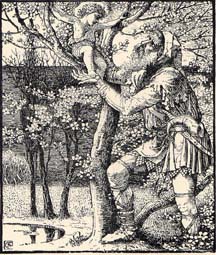Oscar Wilde's Fairy Tales

See if you can master three of the most famous of Oscar Wilde's fairy tales!
- 1.
Oscar Wilde's fairy tales were written for his children, but are in fact for adults.
- A.
True
- B.
False
Correct Answer
A. TrueExplanation
The melancholic ending is a clue...Rate this question:
-
- 2.
The Selfish Giant and The Happy Prince contain the motif of love between elders and children
- A.
True
- B.
False
Correct Answer
A. TrueExplanation
The purest kind of platonic love...Rate this question:
-
- 3.
Female figures appear cold-hearted and frivolous in The Happy Prince and The Nightingale and the Rose, because
- A.
Oscar Wilde prefered men in his private life
- B.
Oscar Wilde thought that women was a decorative sex
- C.
Oscar Wilde wants to underline the value of true love regardless of sex
Correct Answer
C. Oscar Wilde wants to underline the value of true love regardless of sexExplanation
Oscar Wilde wants to underline the value of true love regardless of sex. This is evident in the portrayal of female figures as cold-hearted and frivolous in "The Happy Prince" and "The Nightingale and the Rose." By depicting women in this way, Wilde highlights the superficiality and lack of genuine love in society. This reinforces the idea that true love should not be based on gender or appearances, but on genuine emotions and connections between individuals.Rate this question:
-
- 4.
The Selfish giant wants his beautiful to himself and doesn't allow the children to come and .His heart will melt when the youngest, who cannot climb a tree, asks him to help him. When the Giant does, the child gives him a and melts his selfish heart. Years after, they meet again, but the child shows the Giant the marks of nails on his hands and . He is Jesus, and has come to take the Giant to His own garden, Paradise, in return for what he had done.
Correct Answer
garden, play, kiss, feetExplanation
The Selfish Giant initially wants to keep his beautiful garden to himself and does not allow children to come and play in it. However, his heart softens when the youngest child, who is unable to climb a tree, asks for his help. The Giant helps the child and in return, the child gives him a kiss, which melts the Giant's selfish heart. Years later, they meet again and the child, who is revealed to be Jesus, shows the Giant the marks of nails on his hands and feet. This signifies that Jesus has come to take the Giant to Paradise, his own garden, as a reward for his kindness.Rate this question:
- 5.
The religious feeling in the Selfish Giant is more aesthetically felt than authentic.
- A.
True
- B.
False
Correct Answer
A. TrueExplanation
Oscar Wilde was christened a catholic just before his death.Rate this question:
-
- 6.
In The Happy Prince there is hidden social critisism in...
- A.
The fact that the prince was sheltered from unhapinness when he was alive
- B.
The fact that cruel children threw stones to the swallow
- C.
The fact that upper classes have no feelings for working people, like the seamstress
- D.
The fact that the Town's leaders only appreciated a statue for its beauty and not its historic value
- E.
The fact that a statue covered with gold stood in a town full of poor people.
Correct Answer(s)
A. The fact that the prince was sheltered from unhapinness when he was alive
B. The fact that cruel children threw stones to the swallow
C. The fact that upper classes have no feelings for working people, like the seamstress
D. The fact that the Town's leaders only appreciated a statue for its beauty and not its historic value
E. The fact that a statue covered with gold stood in a town full of poor people.Explanation
The correct answer is a comprehensive statement that encompasses all the hidden social criticisms in "The Happy Prince." It highlights various aspects, such as the prince being sheltered from unhappiness, cruel children throwing stones at the swallow, upper classes lacking empathy for working people, the town's leaders valuing beauty over historic value, and a gold-covered statue in a town full of poor people. These critiques shed light on societal issues like privilege, class inequality, lack of compassion, and the superficiality of appearances.Rate this question:
-
- 7.
Do you think the nightingale's sacrifice for the student was worth it? Write three reasons for your answer.
Quiz Review Timeline +
Our quizzes are rigorously reviewed, monitored and continuously updated by our expert board to maintain accuracy, relevance, and timeliness.
-
Current Version
-
Mar 22, 2023Quiz Edited by
ProProfs Editorial Team -
Nov 04, 2008Quiz Created by
Libelefs
 Back to top
Back to top






